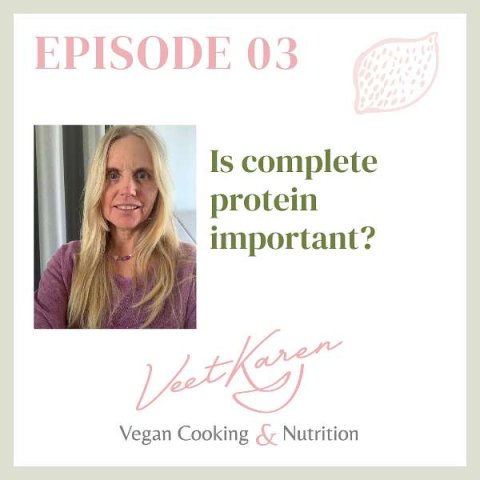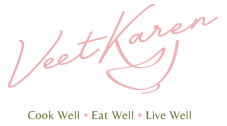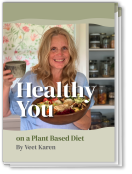
Episode 03
Is Complete Protein important?
In this world of so much information it is hard to work out what is true.
Many say that you don’t need to worry about complete protein, just eat a healthy diet and you will be fine.
Others say it is essential.
I am an advocate for getting complete protein on a plant based diet and here are my thoughts and what I do to get adequate sources of protein on a daily basis.
Listen Now
Show Notes and Links
Complete protein chart https://mailchi.mp/veets.com.au/complete-protein-chart
Hello wonderful cook.
In the last episode I spoke about where I get my protein from and in this episode I will discuss complete protein.
What is complete protein? Is it a myth? Do we need to worry about it? What do I do?
This is episode number three of the Vegan Cooking and Nutrition show where I will discuss my take on complete protein.
For the show notes and relevant links, head on over to https.www.veets.com.au/3
What is Complete Protein?
What the heckfire is complete protein?
It's been bandied around a lot and in the vegan world there seem to be two schools of thought. The main one is that we don't have to worry about complete protein because complete protein was a term that came out in the 70s when industries were pushing meat consumption.
I disagree. I am a complete protein girl. I have created a complete protein chart.
Importance of Complete Protein
I believe in having complete protein in every meal. I think that, especially when you're transitioning into a vegan diet, if you ensure you have complete protein in every meal you're going to feel full, you're going to feel satisfied, you're going to feel energized, you're going to feel like your body is enjoying this new way of eating.
I often do little experiments with myself, like I recently went away and I didn't worry so much about complete protein and I felt hungry so much of the time, that was really good to see.
9 Essential Amino Acids
Complete protein is the term used for any foods that have all nine essential amino acids that our body can't produce itself.
Those amino acids are
Phenylalanine
Valine
Threonine
Tryptophan
Methionine
Leucine
Isoleucine
Lysine
Histidine
They all have different reasons why our body needs them. For example, the three amino acids that are BCAAs (branched-chain amino acids) are valine, isoleucine, and lysine.
They are super important for muscle development, muscle growth, and muscle tissues. This is important to eat, especially if you are doing resistance exercise or bodybuilding. Not all foods have all those nine essential amino acids.
Balanced Diet and Complete Protein
It is true if you are eating a balanced diet, where you've got your vegetables, grains, and legumes or tofu and nuts and seeds and you've got those in each meal, then you will be getting complete protein.
It's also true that if you have something like rice at breakfast and then lentils at lunch, as long as you're having those foods within a 12-hour period your body is going to get complete protein.
So it is true to say that you don't need to worry if you're having complete protein every meal. I catered for 13 years and I catered for big meat eaters and I gave them vegan food that contained complete protein at every single meal.
By adding complete protein at every meal, they felt fully satiated.
Foods with Complete Protein
Let's look at the foods that have complete protein in the vegan diet.
There are some, yay!
There's:
Soy
Hemp seeds (although hemp seeds are a little low in lysine),
Pepitas
Quinoa
Buckwheat
Pistachios.
Chia seeds.
Food Combining for Complete Protein
Then we can do food combining to get the complete protein and that's what's in my chart
The 3 main sources of foods that are high in protein are
Grains/cereals
Legumes/beans
Nuts/seeds
If we were just going to have grains or cereals and that's all we were going to eat all day then they would be lacking in lysine which is one of the BCAAs (branched-chain amino acids) which we need for muscle production, health, and muscle building.
If we were just to eat legumes and nothing else except for soy (because soy has all of them) but if we were just to eat mung beans or chickpeas, it would be low in methionine. Methionine is needed for tissue growth, metabolism, and detoxification.
If we were to eat corn (because corn is a grain) and have nothing else in the day, it would be low in tryptophan. We need tryptophan because it's a precursor to serotonin and is important for sleep and mood.
If we just relied on nuts, we would be low in lysine and, in some of the nuts, low in methionine.
So we need to have a combination of those to get all of the nine essential amino acids.
Traditional Diets and Complete Protein
A great combination together, which you will see in many traditional diets, is a grain plus a legume or bean.
Let's have a look at dhal and rice in India, corn and beans in Mexico, Teff in Ethiopia with peas (which is beans).
There are lots of combinations in different countries.
Even the good old Brits (that's where I was born, England, but I came to Australia when I was three) have baked beans on toast. There's your grain (the wheat in the bread) and the beans (the legumes). That's a complete protein.
In the States, they often eat peanut butter on toast. Peanuts are actually a legume and the toast is grain. So, lots and lots of combinations will make sure that there's complete protein.
There's also hummus, which comes from seeds (tahini) and legumes (chickpeas).
Pesto pasta can work as well.
If you're combining foods, you will make sure that you aren't missing out on those 9 essential amino acids.
Facts about Complete Protein
If you eat foods from the high protein groups within 12 hours of each other, you'll be getting enough complete protein.
You don't need to eat complete every meal, but to be on the safe side and to feel full, do what I do:
Eat a complete protein at every meal.
Let's do an example.
For breakfast, you could have scrambled tofu with veggies. That's going to be a complete protein because it's got the tofu. Or you could have bread with tahini (I said that in the last episode). That's a complete protein. Or bread and peanut butter. That's a complete protein. If you're having porridge, you could have oats with nuts and seeds and soy milk. That's a complete protein.
For lunch, you could have a wrap with chickpea tuna (chickpeas with mayonnaise, capers, gherkins, seaweed, salt, and pepper) and lots of veggies. That's a complete protein.
For dinner, you could have a stew, curry, or soup with lentils and rice. Or you could have a quinoa meal because quinoa is a complete protein. There's plenty to go with for complete protein.
Go to the show notes and get my complete protein chart to see a visual of what I'm talking about.
Recipe: Pepita Sprinkle
Now, heading to the recipe, I'm going to do a pepita sprinkle. It's great to have pepita sprinkle in your fridge because it's just adding some extra complete protein (pepitas have the nine essential amino acids).
1 cup pepitas
½ cup nutritional yeast
1 tsp salt
1 tsp garlic powder (optional)
I get a cup and put them in a frying pan on medium heat.
I just shuzle (move) the frying pan around so that all the pepitas get the heat.
When they start to pop, I give it a good shake. When a lot of them are starting to pop, I take it off the heat and let them cool down.
Once they're cool, I pop them into the food processor with half a cup of nutritional yeast, a teaspoon of garlic or onion powder (if I've got it), and a teaspoon of salt. I process that until it forms a very fine crumb. I call that sprinkle.
We put that in an airtight jar and put it in the fridge.
It will last three months in the fridge, but we'll just have it on everything. We can have it on salads, toast in the morning (depending on what you're having on it), salads, steamed veg, pasta, soups. It just adds that extra bit more complete protein to your meal.
It's a great thing to have.
FCT (Fun Cooking Tip)
If you're using lemon juice in anything, one lemon normally has a quarter of a cup of juice in it (if it's a regular size lemon).
I don't know why I decided to give you that tip today, but it just came to me. When we're making something like quinoa salad, it's really nice to have some lemon juice on it.
In the last episode, I talked about tofu paneer and you needed a quarter cup of lemon juice. Maybe that's where it came from. If you don't have your cup measures handy, normally the juice of one lemon is a quarter cup.
Thank you for listening. Have a wonderful week, and until next time, I hope you cook sensational food.
I hope this helps! Let me know if you need any further assistance and remember to like share and subscribe and download my complete protein chart. 😊




